| blob | 571b102545e3b71031478776a26f03e56917f05c |
1 # Legacy Documentation
3 Multiprotocol is a 2.4GHz transmitter which enables any TX to control lot of different models available on the market.
5 The source code is partly based on the Deviation TX project, thanks to all the developpers for their great job on protocols.
7 [Forum link on RCGROUPS](http://www.rcgroups.com/forums/showthread.php?t=2165676) for additional information or requesting a new protocol integration.
9 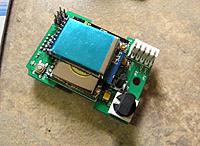 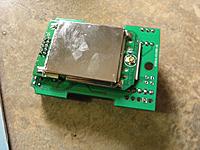
11 **To download the latest compiled version (hex file), click on [Release](https://github.com/pascallanger/DIY-Multiprotocol-TX-Module/releases) on the top menu.**
13 ## Contents
15 [Compatible TX](README-old.md#compatible-tx)
17 [Protocols](README-old.md#protocols)
19 [Hardware](README-old.md#hardware)
21 [Compilation and programmation](README-old.md#compilation-and-programmation)
23 [Troubleshooting](README-old.md#troubleshooting)
25 ## Compatible TX
27 ### Using standard PPM output (trainer port)
28 The multiprotocol TX module can be used on any TX with a trainer port.
30 Channels order is AETR by default but can be changed in the _Config.h.
32 The protocol selection is done via a dip switch, rotary dip switch or scsi ID selector.
34 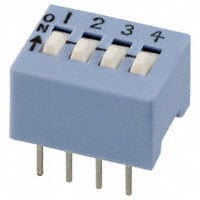
35 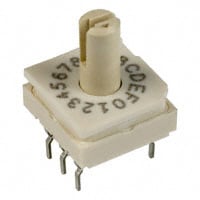
36 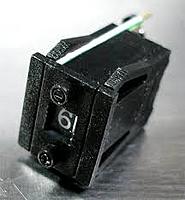
38 You can access to up to 15 different protocols and associated settings.
40 Settings per selection are located in _Config.h:
41 - Protocol and type: many main protocols have variants
42 - RX Num: number your different RXs and make sure only one model will react to the commands
43 - Power: High or low, enables to lower the power setting of your TX (indoor for example).
44 - Option: -127..+127 allowing to set specific protocol options. Like for Hubsan to set the video frequency.
45 - Autobind: Yes or No. At the model selection (or power applied to the TX) a bind sequence will be initiated
47 ### Using a serial output
48 The multiprotocol TX module takes full advantage of being used on a Turnigy 9X, 9XR, 9XR Pro, Taranis, 9Xtreme, AR9X, ... running [er9x](http://openrcforums.com/forum/viewtopic.php?f=5&t=4598) or [ersky9X](http://openrcforums.com/forum/viewtopic.php?f=7&t=4676). An OpenTX version for Taranis is available [here](http://plaisthos.de/opentx/).
50 This enables full integration using the radio GUI to setup models with all the available protocols options.
52 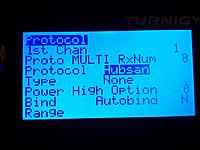
54 Options are:
55 - Protocol and type: many main protocols have variants
56 - RX Num: number your different RXs and make sure only one model will react to the commands
57 - Power: High or low, enables to lower the power setting of your TX (indoor for example).
58 - Option: -127..+127 allowing to set specific protocol options. Like for Hubsan to set the video frequency.
59 - Bind: bind a RX/model
60 - Autobind: Yes or No. At the model selection (or power applied to the TX) a bind sequence will be initiated
61 - Range: test range by setting the transmission power to the lowest value
63 Notes:
64 - Using this solution does not need any modification of the TX since it uses the TX module slot PPM pin for serial transfer.
65 - There are 2 versions of serial protocol either 8 or 16 channels. 16 channels is the latest and only available version going forward. Make sure to use the right version based on your version of er9x/ersky9x.
66 - Channels order is AETR by default but can be changed in _Config.h.
68 ### Telemetry
70 There are 4 protocols supporting telemetry: Hubsan, DSM, FrSkyD and FrSkyX.
72 Hubsan displays the battery voltage and TX RSSI.
74 DSM displays TX RSSI and full telemetry.
76 FrSkyD displays full telemetry (A0, A1, RX RSSI, TX RSSI and Hub).
78 FrSkyX displays full telemetry (A1, A2, RX RSSI, TX RSSI and Hub).
80 ### If used in PPM mode
82 Telemetry is available as a serial 9600 8 n 1 output on the TX pin of the Atmega328p using the FrSky hub format for Hubsan, FrSkyD, FrSkyX and DSM format for DSM2/X.
84 You can connect it to your TX if it is telemetry enabled or use a bluetooth adapter (HC05/HC06) along with an app on your phone/tablet ([app example](https://play.google.com/store/apps/details?id=biz.onomato.frskydash&hl=fr)) to display telemetry information and setup alerts.
86 ### If used in Serial mode
87 Telemetry is built in for er9x and ersky9x TXs.
89 To enable telemetry on a Turnigy 9X or 9XR you need to modify your TX following one of the Frsky mod like this [one](http://blog.oscarliang.net/turnigy-9x-advance-mod/).
91 Note: DSM telemetry is not available on er9x due to a lack of flash space.
93 Enabling telemetry on a 9XR PRO and may be other TXs does not require any hardware modifications. The additional required serial pin is already available on the TX back module pins.
95 Once the TX is telemetry enabled, it just needs to be configured on the model (see er9x/ersky9x documentation).
97 ## Protocols
99 ### TX ID
100 The multiprotocol TX module is using a 32bits ID generated randomly at first power up. This global ID is used by nearly all protocols.
101 There are little chances to get a duplicated ID.
103 For DSM2/X and Devo the CYRF6936 unique manufacturer ID is used.
105 It's possible to generate a new ID using bind button on the Hubsan protocol during power up.
107 ### Bind
108 To bind a model in PPM Mode press the physical bind button, apply power and then release.
110 In Serial Mode you have 2 options:
111 - use the GUI, access the model protocol page and long press on Bind. This operation can be done at anytime.
112 - press the physical bind button, apply power and then release. It will request a bind of the first loaded model protocol.
114 Notes:
115 - the physical bind button is only effective at power up. Pressing the button later has no effects.
116 - a bind in progress is indicated by the LED fast blinking. Make sure to bind during this period.
118 ### Protocol selection
120 #### Using the dial for PPM input
121 PPM is only allowing access to a subset of existing protocols.
122 The protocols, subprotocols and all other settings can be personalized by modifying the **_Config.h** file.
124 The default association dial position / protocol in every release is listed below.
126 Dial|Protocol|Sub_protocol|RX Num|Power|Auto Bind|Option|RF Module
127 ----|--------|------------|------|-----|---------|------|---------
128 0|Select serial||||||
129 1|FLYSKY|Flysky|0|High|No|0|A7105
130 2|HUBSAN|-|0|High|No|0|A7105
131 3|FRSKYD|-|0|High|No|-41|CC2500
132 4|HISKY|Hisky|0|High|No|0|NRF24L01
133 5|V2X2|-|0|High|No|0|NRF24L01
134 6|DSM|DSM2|0|High|No|6|CYRF6936
135 7|DEVO|-|0|High|No|0|CYRF6936
136 8|YD717|YD717|0|High|No|0|NRF24L01
137 9|KN|WLTOYS|0|High|No|0|NRF24L01
138 10|SYMAX|SYMAX|0|High|No|0|NRF24L01
139 11|SLT|-|0|High|No|0|NRF24L01
140 12|CX10|BLUE|0|High|No|0|NRF24L01
141 13|CG023|CG023|0|High|No|0|NRF24L01
142 14|BAYANG|-|0|High|No|0|NRF24L01
143 15|SYMAX|SYMAX5C|0|High|No|0|NRF24L01
145 Note:
146 - The dial selection must be done before the power is applied.
148 #### Using serial input with er9x/ersky9x
149 Serial is allowing access to all existing protocols & sub_protocols listed below.
151 ##### A7105 RF module
152 Protocol|Sub_protocol
153 --------|------------
154 Flysky|
155 |Flysky
156 |V9x9
157 |V6x6
158 |V912
159 Hubsan|
161 ##### CC2500 RF module
162 Protocol|Sub_protocol
163 --------|------------
164 FrSkyV|
165 FrSkyD|
166 FrSkyX|
167 |CH_16
168 |CH_8
169 SFHSS|
171 ##### CYRF6936 RF module
172 Protocol|Sub_protocol
173 --------|------------
174 DSM|
175 |DSM2
176 |DSMX
177 Devo|
178 J6Pro|
180 ##### NRF24L01 RF module
181 Protocol|Sub_protocol
182 --------|------------
183 Hisky|
184 |Hisky
185 |HK310
186 V2x2|
187 YD717|
188 |YD717
189 |SKYWLKR
190 |SYMAX4
191 |XINXUN
192 |NIHUI
193 KN|
194 |WLTOYS
195 |FEILUN
196 SymaX|
197 |SYMAX
198 |SYMAX5C
199 SLT|
200 CX10|
201 |GREEN
202 |BLUE
203 |DM007
204 |Q282
205 |JC3015_1
206 |JC3015_2
207 |MK33041
208 |Q242
209 CG023|
210 |CG023
211 |YD829
212 |H8_3D
213 Bayang|
214 ESky|
215 MT99XX|
216 |MT
217 |H7
218 |YZ
219 |LS
220 MJXQ|
221 |WLH08
222 |X600
223 |X800
224 |H26D
225 |E010
226 Shenqi|
227 FY326|
228 FQ777|
229 ASSAN|
230 HONTAI|
231 |HONTAI
232 |JJRCX1
233 |X5C1
235 Note:
236 - The dial should be set to 0 for serial. Which means all protocol selection pins should be left unconnected.
238 ### Protocols details
239 **Check the [Protocols_Details.md](./Protocols_Details.md) file for a detailed description of every protocols with channels assignements.**
241 ## Hardware
243 ### RF modules
244 Up to 4 RF modules can be installed:
245 - [A7105](http://www.banggood.com/XL7105-D03-A7105-Modification-Module-Support-Deviation-Galee-Flysky-p-922603.html) for Flysky, Hubsan
246 - [CC2500](http://www.banggood.com/CC2500-PA-LNA-Romote-Wireless-Module-CC2500-SI4432-NRF24L01-p-922595.html) for FrSkyV, FrSkyD, FrSkyX and SFHSS
247 - [CYRF6936](http://www.ehirobo.com/walkera-wk-devo-s-mod-devo-8-or-12-to-devo-8s-or-12s-upgrade-module.html) for DSM, DEVO, J6Pro
248 - [NRF24L01](http://www.banggood.com/2_4G-NRF24L01-PA-LNA-Wireless-Module-1632mm-Without-Antenna-p-922601.html) for Hisky, V2x2, CX-10, SYMAX and plenty other protocols
250 RF modules can be installed for protocols need only. Example: if you only need the Hubsan protocol then install only a A7105 on your board.
252 You also need some [antennas](http://www.banggood.com/2_4GHz-3dBi-RP-SMA-Connector-Booster-Wireless-Antenna-Modem-Router-p-979407.html) and [cables](http://www.banggood.com/10cm-PCI-UFL-IPX-to-RPSMA-Female-Jack-Pigtail-Cable-p-924933.html).
254 ### Board
255 The main program is running on an ATMEGA328p running @16MHz and 3.3V.
256 An [Arduino pro mini 16Mhz/5V](http://www.banggood.com/Wholesale-New-Ver-Pro-Mini-ATMEGA328-328p-5V-16MHz-Arduino-Compatible-Nano-Size-p-68534.html) powered at 3.3V (yes it works) can be used to build your own Multimodule. An Arduino Mini based on Atmega328p can also be used.
258 #### Using stripboard:
260 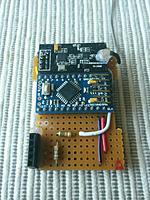
261 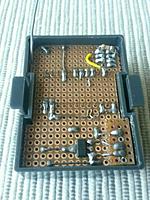
263 #### Using a [home made PCB](http://www.rcgroups.com/forums/showpost.php?p=32645328&postcount=1621):
265 
266 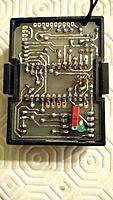
268 #### Build your own board using [SMD components](http://www.rcgroups.com/forums/showpost.php?p=31064232&postcount=1020) and an [associated PCB v2.3c](https://oshpark.com/shared_projects/MaGYDg0y):
270 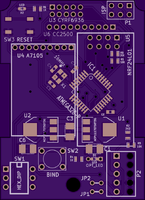
271 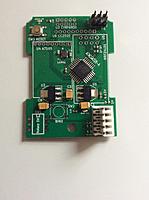
272  
274 If you build this PCB v2.3c and want to enable serial mode for er9x/ersky9x, you have to do [this mod](http://static.rcgroups.net/forums/attachments/4/0/8/5/8/3/a8667856-242-multi.jpg).
276 **[New PCB v2.3d!](https://github.com/pascallanger/DIY-Multiprotocol-TX-Module/tree/master/PCB%20v2.3d) available**
278 Repository includes Kicad files of schematic and pcb. This is a variant of the Multipro V2.3c circuit design. It is basicly the same as the 2.3c board as far as component placement goes. What's changed is the added resistors for the serial protocol and also
279 the addition of solder jumpers on the bottom of the board for the various options to connect the TX, RX, and PPM
280 lines through them.
282 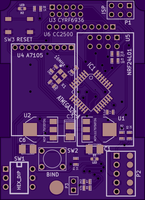
283 
285 [OSH Park link](https://oshpark.com/shared_projects/Ztus1ah8) if you want to order.
287 #### Buy a ready to use and complete Multi module
288 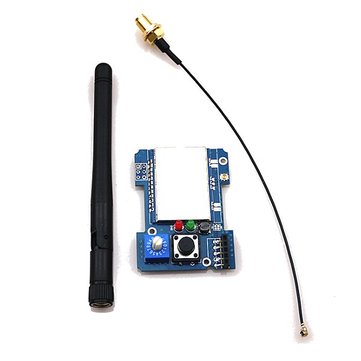
290 This module can be purchased [here](http://www.banggood.com/2_4G-CC2500-A7105-Flysky-Frsky-Devo-DSM2-Multiprotocol-TX-Module-With-Antenna-p-1048377.html). All the 4 RF modules are already implemented A7105, NRF24L01, CC2500 and CYRF6936. The board is also equiped with an antenna switcher which means only one antenna for all.
292 **It is highly recommended to update the firmware** of this board as it is distributed with a really old and bugged one. For this you have to solder a 6 pin header (top left) and use an USBASP like explained [below](https://github.com/pascallanger/DIY-Multiprotocol-TX-Module#upload-the-code-using-isp-in-system-programming).
294 If you want to enable serial mode for er9x/ersky9x/Taranis/... and depending on your board revision, you have to do one of these modifications:
295 - 1st revision, add 2 resistors as shown here: 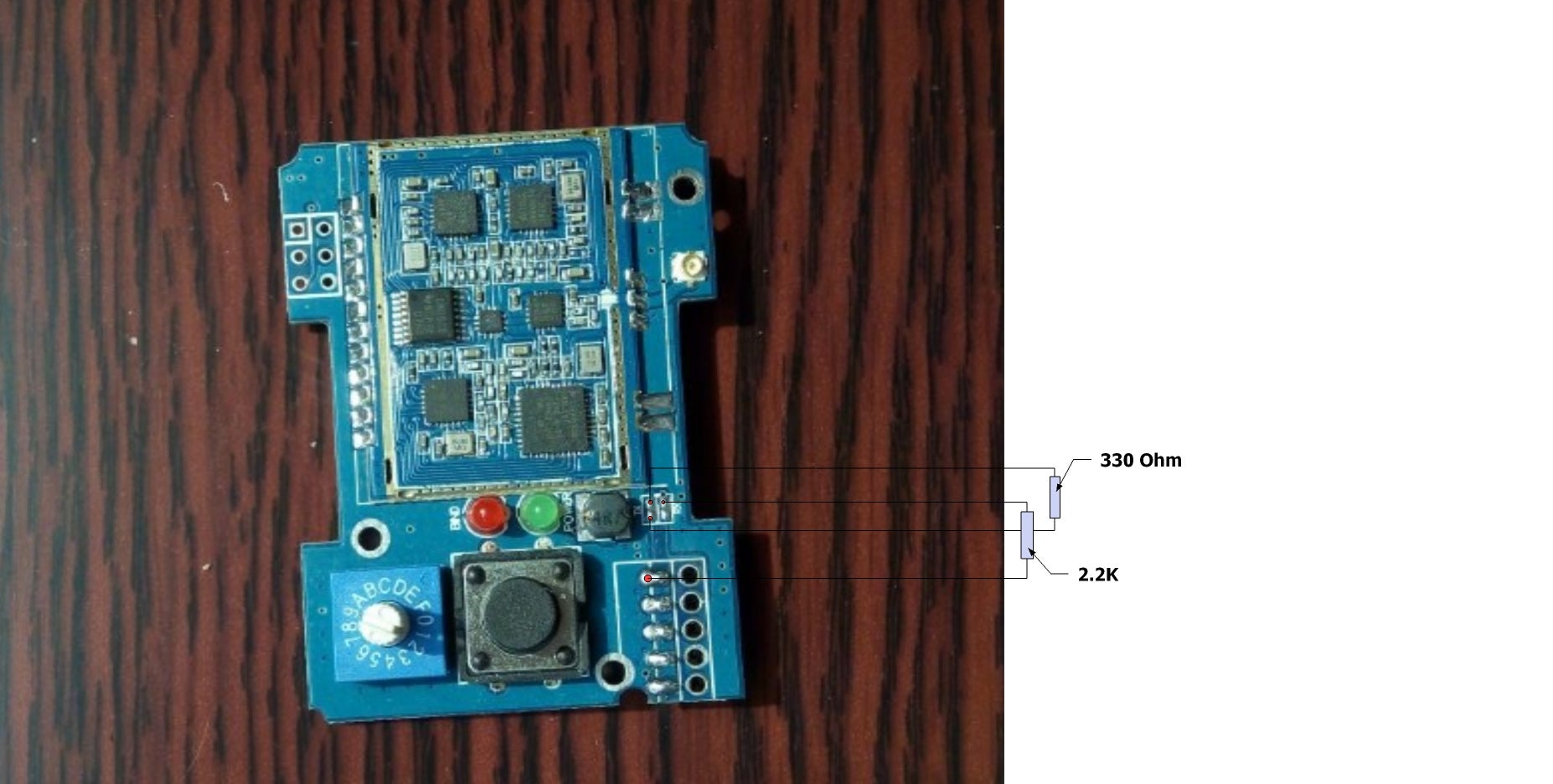
296 - 2nd revision, solder pads together as shown: <br> <img src="http://static.rcgroups.net/forums/attachments/4/8/3/5/8/4/a9206217-177-IMG_5790.jpg" width="350">
298 Note: if you have the 1st board revision (check pictures above), sometime bind occures at power up even without pressing the bind button or not having an autobind protocol. To solve this issue, replacing the BIND led resistor (on the board back) of 1.2K by a 4.7K.
300 ### Schematic
301 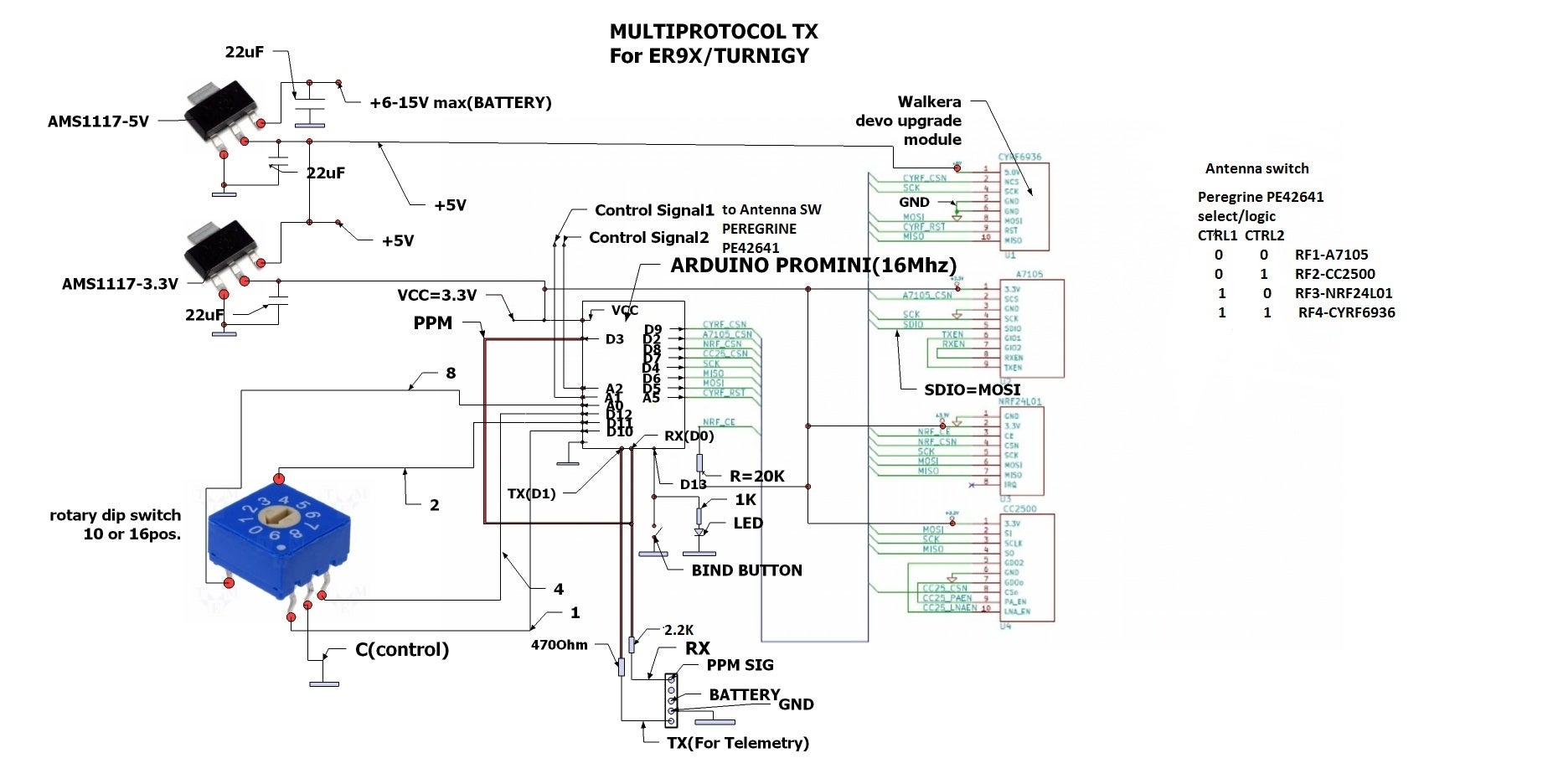
303 Notes:
304 - Attention: All modules are 3.3V only, never power them with 5V.
305 - For serial, the dial switch is not needed and the bind button optionnal
307 ### Radio integration
308 If you build your own version of the board you can 3D print this case (details [here](http://www.rcgroups.com/forums/showpost.php?p=33294140&postcount=2034)):
310 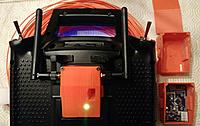
311 
313 If you have the Banggood ready to use board you can 3D print this case (details [here](http://www.rcgroups.com/forums/showpost.php?p=35349049&postcount=3)):
315 <img src="http://static.rcgroups.net/forums/attachments/4/8/3/5/8/4/a9206211-97-Screen%20Shot%202016-07-27%20at%2011.02.35%20am.png" width="200">
316 <img src="http://static.rcgroups.net/forums/attachments/4/8/3/5/8/4/a9206411-90-IMG_5793.jpeg" width="200">
317 <img src="http://static.rcgroups.net/forums/attachments/4/8/3/5/8/4/a9206445-131-IMG_5796.jpeg" width="200">
319 ## Compilation and programmation
321 ### Toolchain
322 Multiprotocol source can be compiled using the Arduino IDE.
324 The currently supported Arduino version is [1.6.10](https://www.arduino.cc/download_handler.php?f=/arduino-1.6.10-windows.exe).
326 Download the [zip file](https://github.com/pascallanger/DIY-Multiprotocol-TX-Module/archive/master.zip) of this repository, unzip it in a folder, navigate to the Multiprotocol directory and then click on Multiprotocol.ino. The Arduino environment will appear and the Multiprotocol project will be loaded.
328 **[_Config.h file](https://github.com/pascallanger/DIY-Multiprotocol-TX-Module/blob/master/Multiprotocol/_Config.h) must be modified** to select which protocols will be available, change protocols/sub_protocols/settings associated with dial for PPM input, different TX channel orders and timing, Telemetry or not, ...
329 This is mandatory since all available protocols will not fit in the ATmega328. You need to pick and choose what you want.
331 Notes:
332 - Make sure to select "Arduino Pro or Pro Mini, ATmega328 (5V,16MHz)" before compiling.
333 - Compilation of the code posted here works. So if it doesn't for you this is a problem with your setup, please double check everything before asking.
334 - If you want to reduce the code size even further, you can modify the file platform.txt located in "C:\Program Files (x86)\Arduino\hardware\arduino\avr". Set the line "compiler.c.elf.extra_flags=" to "compiler.c.elf.extra_flags=-Wl,--relax".
336 ### Upload the code using ISP (In System Programming)
337 It is recommended to use an external programmer like [USBASP](http://www.banggood.com/USBASP-USBISP-3_3-5V-AVR-Downloader-Programmer-With-ATMEGA8-ATMEGA128-p-934425.html) to upload the code in the Atmega328. The programmer should be set to 3.3V or nothing to not supply any over voltage to the multimodule and avoid any damages.
339 The dial must be set to 0 before flashing!
341 From the Arduino environment, you can use this shortcut to compile and upload to the module: Skecth->Upload Using Programmer (Ctrl+Maj+U)
343 To flash the latest provided hex file under [Release](https://github.com/pascallanger/DIY-Multiprotocol-TX-Module/releases), you can use a tool like [AVR Burn-O-Mat](http://avr8-burn-o-mat.aaabbb.de/), set the microcontroller to m328p and flash it.
345 ### Upload the code using FTDI (USB serial to TTL)
346 Use this method only for Arduino Pro Mini boards with bootloader.
348 Use an external FTDI adapter like [this one](http://www.banggood.com/FT232RL-FTDI-USB-To-TTL-Serial-Converter-Adapter-Module-For-Arduino-p-917226.html).
350 The programmer should be set to 3.3V or nothing to not supply any over voltage to the multimodule and avoid any damages.
352 From the Arduino environment, you can use Upload button which will compile and upload to the module: Skecth->Upload (Ctrl+U)
354 To upload the latest provided hex file under [Release](https://github.com/pascallanger/DIY-Multiprotocol-TX-Module/releases), you can use a tool like [XLoader](http://russemotto.com/xloader/), set the microcontroller to Atmega328 and upload it.
356 ### Set fuses
357 Use a tool like [AVR Burn-O-Mat](http://avr8-burn-o-mat.aaabbb.de/) to set the fuses of the Atmega328 to:
358 - Extended Fuse 0x05 (or 0xFD which is the same)
359 - High Fuse 0xD2
360 - Low Fuse 0xFF
362 This will make sure your ATMEGA328 is well configured and the global TX ID is not erased at each updates.
364 ## Troubleshooting
366 ### LED status
367 - off: program not running or a protocol selected with the associated module not installed.
368 - flash(on=0.1s,off=1s): invalid protocol selected (excluded from compilation or invalid protocol number)
369 - slow blink(on=0.5s,off=0.5s): serial has been selected but no valid signal has been seen on the RX pin.
370 - fast blink(on=0.1s,off=0.1s): bind in progress.
371 - on: normal operation.
373 ### Protocol selection
374 #### Input Mode - PPM
375 - The protocol/mode selection must be done before the power is applied.
376 - Connect 1 to 4 of the selection protocol pins to GND.
378 #### Input Mode - Serial
379 - Make sure you have done the mods to the v2.3c PCB by adding the 2.2k and 470 ohm resistors as indicated in the [Board section] (https://github.com/pascallanger/DIY-Multiprotocol-TX-Module#board).
380 - Leave all 4 selection pins unconnected.
382 ### Bind
383 Make sure to follow this procedure: press the bind button, apply power and then release it after 1sec. The LED should be blinking fast indicating a bind status and then fixed on when the bind period is over. It's normal that the LED turns off when you press the bind button, this behavior is not controlled by the Atmega328.
384 For serial, the preffered method is to bind via the GUI protocol page.
386 If your module is always/sometime binding at power up without pressing the button:
387 - Arduino Pro Mini with an external status LED: to work around this issue connect a 10K resistor between D13 and 3.3V.
388 - 4in1 module V1 (check 4in1 pictures): to solve this issue, replacing the BIND led resistor (on the board back) of 1.2K by a 4.7K.
390 ### Report issues
391 You can report your problem using the [GitHub issue](https://github.com/pascallanger/DIY-Multiprotocol-TX-Module/issues) system or go to the [Main thread on RCGROUPS](http://www.rcgroups.com/forums/showthread.php?t=2165676) to ask your question.
392 Please provide the following information:
393 - Multiprotocol code version
394 - TX type
395 - Using PPM or Serial, if using er9x or ersky9x the version in use
396 - Different led status (multimodule and model)
397 - Explanation of the behavior and reproduction steps